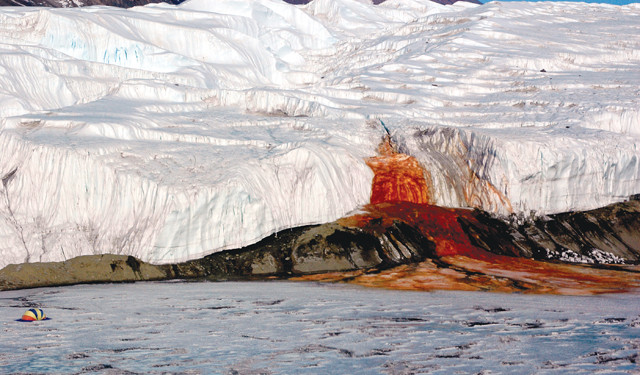
by Timothy Oleson Friday, July 17, 2015

An eerie red ooze, rich in microbes and iron oxides (hence the color), issues from Blood Falls at the toe of Antarctica's Taylor Glacier. Credit: National Science Foundation/Peter Rejcek.
From Antarctica to the Arctic; from polar caps, permafrost and glaciers to ocean-rafted sea ice; and from burly bears to cold-loving microbes, fascinating science is found in every nook and crevasse of Earth’s cryosphere, and new findings are announced often. Here are a few of the latest updates.
Scientists have found evidence that briny, subzero-Celsius groundwater courses beneath one of Antarctica’s McMurdo Dry Valleys, connecting surface lakes and likely sustaining microbial colonies adapted for the extreme cold. The ground below Taylor Valley and its lakes, near the coastline of the Ross Sea, was long thought to be frozen solid. But data collected using a helicopter-mounted electromagnetic sensor, which detected electrically conductive saltwater deep below the surface, suggest otherwise, wrote Jill Mikucki of the University of Tennessee and colleagues in Nature Communications. They reported the existence of large groundwater conduits more than 100 meters below the land surface that extend at least 40 kilometers inland from the coast. This brine reservoir is a likely source for the distinctive Blood Falls, where a salty, microbe-rich ooze stained red with iron oxides seeps from the toe of Taylor Glacier, the researchers noted.
Heat produced by microbes in permafrost soils may enhance ongoing thawing in the Arctic, potentially accelerating the release of carbon once trand to the atmosphere, according to a new study in Nature Climate Change. Researchers led by Jørgen Hollesen of the University of Copenhagen in Denmark found that microbes in 21 different organic-rich permafrost soils collected from different parts of d were all capable of producing a significant amount of heat. Incorporating their measurements into simulations of soil conditions, they observed that, in warmer parts of Greenland, the heat generated by microbes could warm soils by an additional 2 to 7 degrees Celsius by 2100 beyond warming predicted by climate models. This would thaw more permafrost and release more carbon. However, they noted, in areas where the air and soil temperatures are inherently colder, the added effect of microbial heat will likely have a far more limited impact on permafrost thawing.
Two new studies tell unfortunate stories for glacier lovers. According to research published recently in Science, seaside ice shelves along the Southern Antarctic Peninsula have rapidly been losing mass since 2009. Prior to that, measurements suggested that the shelves were gaining new ice at about the same rate they were melting, resulting in zero net ice loss in the region. But between 2010 and 2014, satellite altimetry and gravity measurements show the area has added 300 trillion liters of water to the ocean, reported Bert Wouters of the University of Bristol in England and colleagues. Relatively warm ocean waters penetrating below the ice appear to be driving the mass loss, the team reported, which may contribute to destabilizing the shelves.
Meanwhile, a study in Nature Geoscience suggests that glaciers in western Canada will lose 70 percent of their volume by 2100 (relative to 2005 volumes). To assess the fate of glaciers in Alberta and British Columbia covering a combined 26,700 square kilometers, according to a 2010 estimate, Garry Clarke of Canada’s University of British Columbia and colleagues coupled a glacier surface-mass balance model with a physics-based model of ice dynamics — a finer-scale approach than previous studies have used. Under projected climate conditions, Clarke’s team found that melting will reach peak rates between 2020 and 2040, with inland mountain glaciers largely disappearing by 2100 while maritime glaciers “will survive in a diminished state.”
© 2008-2021. All rights reserved. Any copying, redistribution or retransmission of any of the contents of this service without the expressed written permission of the American Geosciences Institute is expressly prohibited. Click here for all copyright requests.